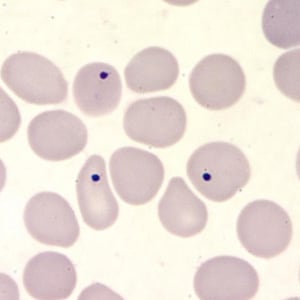It is an inherited disease characterized by the presence of crescent-shaped, sickled RBCs. Sickled cells are removed by the spleen causing anemia. Sickled cells also occlude microcirculation leading to tissue ischemia and infarction. The underlying abnormality is the presence of atypical Hb called HbS which becomes relatively insoluble and forms aggregates or polymers with other hemoglobin molecules within the RBC, under deoxygenated conditions. It is produced from mutations in the HBB gene which normally codes for the beta globin chain of hemoglobin. The disease causing mutation is a point mutation in the HBB gene (chromosome 11) resulting from a single amino acid substitution (valine for glutamic acid) at the 6th position in the β globin chain. Patients with HbSS are less susceptible to P.falciparum malaria. It is more common in the African American population.
RBCs in SCA also appear to have an increased binding affinity for vascular endothelium. Intimal hyperplasia is also seen. Above factors along with RBC sickling puts patients at risk of vaso-occlusive crises. In young children, vaso-occlusive crises most commonly manifest as dactylitis, a painful swelling of the hands, fingers, feet, and toes. Osteomyelitis, osteonecrosis, splenic infarct, splenic sequestration, acute chest syndrome, stroke, papillary necrosis, and renal insufficiency can also occur in SCA. Pulmonary complications are the leading cause of death in SCA. Pneumonia in SCA is most commonly caused by Streptococcus pneumoniae, Haemophilus influenzae, Staphylococcus aureus, Chlamydia pneumoniae, and Salmonella organisms.
Acute chest syndrome: It is a complication of SCA which is precipitated by infections like bacterial pneumonias, pulmonary vascular occlusion, fat embolism from bone infarcts, opioid use, Parvovirus B19 and general anesthesia. Any of these factors may cause local de-oxygenation and precipitate the crises. It presents acutely with fever, chest pain, cough, dyspnea, tachypnea and respiratory distress syndrome. It is more common in children with SCA. CxR shows single or multiple areas of pulmonary consolidation. Treatment consists of hydration, transfusion, supplemental oxygen, and analgesia. Supportive measures like antibiotics, steroids and mechanical ventilation may be needed.
Pain crises: They present as acute and recurrent episodes of mild to severe pain, often near the joints, chest, back, abdomen, upper and lower limbs. They are caused by vaso-occlusion leading to ischemia. Dehydration, extremes of temperature, exposure to low atmospheric oxygen such as high altitude, infections, strenuous exercise etc. can precipitate pain crises. It is managed with adequate pain relief, if needed with opioids, hydroxyurea, intravenous fluids, oxygen and blood transfusion.
Skeletal complications: “Hair on end” appearance of skull is seen due to medullary expansion and diploic space widening. Increased bone marrow cellularity predisposes to bone hypoxia, infarction and osteomyelitis. Repeated infarctions cause osteonecrosis. “Lincoln log” or “H-shaped” vertebral deformity is seen. Dactylitis or hand-foot syndrome is often the first clinical manifestation of SCA. It presents with fever and painful, swollen hands and feet, most commonly seen in children younger than 4 years of age. It is caused by bone infarction along with subperiosteal new bone formation. X ray shows “moth-eaten” appearance of the bones. Osteomyelitis is seen in the diaphysis of long bones like femur, tibia and humerus in SCA. It presents with pain, fever and erythema. The most commonly encountered organism is Salmonella (especially the nontypical serotypes S typhimurium, S enteritidis, S choleraesuis, and S paratyphi B), followed by S aureus.
Splenic complications: Patients with SCA undergo autosplenectomy due to recurrent infarctions. The spleen becomes fibrotic and calcified. It may occur by early childhood. It makes them prone to infection with S pneumoniae, H influenzae type B, and Salmonella, Klebsiella, and other encapsulated bacteria. Penicillin prophylaxis is required, as well as pneumococcal and H.influenzae vaccines. Splenic sequestration syndrome is a feared and potentially fatal complication. It is characterized by rapid pooling of blood within the spleen, intravascular volume depletion, rapid reduction in Hb and hematocrit, left upper quadrant pain, abdominal fullness, splenomegaly and cardiovascular collapse. Splenic sequestration is triggered by antecedent viral infections, pain crises or bacteremia and is more common in young children. It is managed by blood transfusions and splenectomy, if recurrent.

Howell-Jolly bodies in a thin blood smear, stained with Giemsa. Howell-Jolly bodies are inclusion that may be seen in splenectomized patients or patients with an otherwise non-functioning or atrophic spleen, and in patients with severe anemia or leukemia.
Other common complications: Cerebral infarcts may occur from vaso-occlusion. Renal complications include nephrotic syndrome, glomerulosclerosis with proteinuria, papillary necrosis and reduced concentrating capacity of the kidney. Priapism or painful, prolonged penile erection may occur as recurrent episodes. Pulmonary hypertension may develop in long standing cases.
Diagnosis and Treatment: Diagnosis is by clinical features, peripheral smear showing sickle cells, positive sickling test and electrophoresis. Hb electrophoresis in SCA shows mainly HbS, absent HbA and 2-20% HbF. Blood transfusions, desferrioxamine to treat iron overload, bone marrow and stem cell transplant are used as therapy. Hydroxyurea or hydroxycarbamide induces the production of HbF, and is used in treatment.
Sign up for free to take 3 quiz questions on this topic